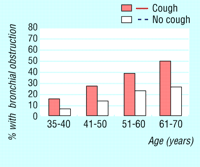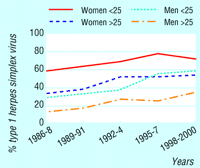This week in the BMJ
Volume 324, Number 7350, Issue of 8 Jun 2002Illness is a risk factor for suicide
Case finding identifies chronic obstructive pulmonary disease
Accurate sedation reduces ventilation time
Delay in licensing drugs costs lives
How to manage childhood eczema
Probiotics can prevent diarrhoea
Zinc reduces the incidence of pneumonia
Genital herpes infections increase in Scotland
Illness is a risk factor for suicide
Visual impairment, neurological disorder, and malignant disease
are all independently associated with suicide in elderly people. In a
case-control study Waern and colleagues (p 1355) examined the
consecutive records of 85 people who had committed suicide and had
undergone forensic examination and of 135 living controls taken from
the tax register. They found that serious illness was a risk factor for
suicide, but when the sexes were analysed separately the association
was not seen in women. The authors say this may be due to the small
sample size.

(Credit: RED JAMES/PHOTONICA)
Case finding identifies chronic obstructive pulmonary disease
Smokers with a chronic cough who are older than 60 have a 48%
chance of having bronchial obstruction. Van Schayck and colleagues (p 1370) studied 651 smokers in two general practices. They found that
201 smokers were not taking drugs for a pulmonary condition and 18% of
these had an FEV1 <80% of predicted. Chronic cough and
increasing age were also good predictors of pulmonary obstruction. The
authors conclude that case finding, rather than screening a whole
practice population, is a feasible method for identifying chronic
obstructive pulmonary disease in general practice and can be
implemented by practice assistants.

Accurate sedation reduces ventilation time
Patients with respiratory failure who need to be ventilated are usually
given analgesia and sedatives, yet this practice often prolongs
ventilator time because of oversedation through continuous infusion.
Brattebo and colleagues (p 1386) decreased ventilator time by 2.1 days
by introducing a package of measures, including a sedation scoring
system and sedation protocol. The protocol allowed nurses to adjust the
sedation according to the levels set by doctors. Mean ventilator time
decreased from 7.4 days to 5.3 days after the intervention was introduced.
Delay in licensing drugs costs lives
Licensing authorities require that drugs have a clinically meaningful
effect, and in the case of anticancer drugs this is taken to mean an
increase in survival compared with standard treatment. However, waiting
for these clinical endpoints poses a dilemma, as the introduction of a
potentially valuable drug may be delayed considerably. Koopmans
(p 1389) argues that other endpoints and quality of life data should
be used and that the effect on survival could be investigated after the
drug is marketed.
How to manage childhood eczema
One in 10 children in developed countries are affected by atopic
eczema. Barnetson and Rogers (p 1376) give an overview of the clinical
features, psychological factors, precipitating factors, and management
of the condition. Four in five children with atopic eczema have IgE
mediated allergy to inhalants or foods. The highest proportion of IgE
is produced against house dust mite, making the mite the most important
allergen in the exacerbation of eczema. Food allergy, however, is an
exacerbating factor in fewer than one in 10 children. For children with
severe eczema, topical or oral immunosuppression can reduce the need
for hospital admission.

Probiotics can prevent diarrhoea
A systematic review of nine trials by D'Souza and colleagues (p 1361)
finds that probiotics can be used to prevent antibiotic associated
diarrhoea, but that their efficacy in treating the condition remains to
be proved. Probiotics are becoming increasingly available as capsules
and dairy based food supplements and have few side effects. The authors
say that doctors should consider using them to prevent antibiotic
associated diarrhoea and infection with Clostridium
difficile.

(Credit: CORDELIA MOLLOY/SPL)
Zinc reduces the incidence of pneumonia
Zinc supplementation reduces the incidence of pneumonia in
children living in a slum community in New Delhi, India. In a
randomised controlled trial by Bhandari and colleagues (p 1358),
daily elemental zinc supplementation, together with a single dose
of vitamin A, reduced the risk of pneumonia substantially more than in
children who received daily placebo and vitamin A. The incidence of
lower respiratory tract infections was the same in both groups. The authors say that measures to improve zinc status through food fortification or dietary diversification are warranted.

(Credit: PANOS)
Genital herpes infections increase in Scotland
Genital infections caused by herpes simplex virus type 1 have
become more common in western Scotland over the past 15 years, particularly among young women. Of 3181 swabs that were positive for
the virus, Scoular and colleagues (p 1366) found 63% were from women
and 37% were from men. Presence of the virus was strongly associated
with female sex and younger age. In 1986-8, 33% of all positive swabs
contained herpes simplex virus type 1, rising progressively to 56% in
1998-2000. These results suggest that counselling and clinical
management strategies may need to be revised.
